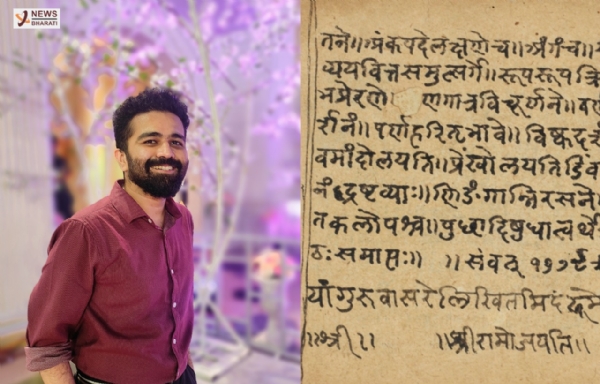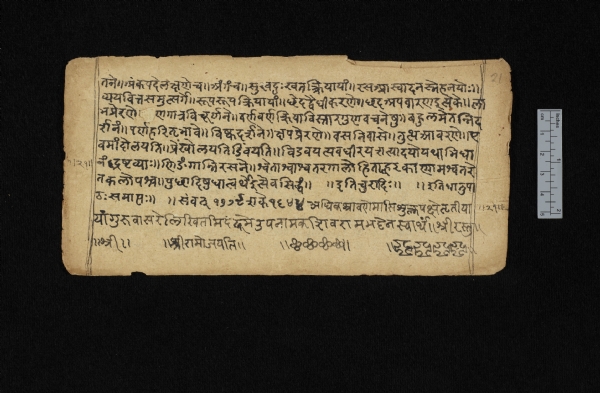PANINIAN GENIUS! Rishi Rajpopat's discovery on Panini's language machine to revolutionize Sanskrit grammar
The discovery makes it possible to “derive” any Sanskrit word – constructing millions of grammatically correct words including “mantra” and “guru” – using Paṇini"s famous “language machine.”
Total Views |
An ancient grammatical puzzle that has baffled Sanskrit scholars and scientists for 2,500 years has been solved by a University of Cambridge student. PhD scholar Rishi Rajpopat finally cracked the riddle which has defeated Sanskrit experts since the 5th Century BC.

The 27-year-old accomplished the feat by decoding a rule taught by “the father of linguistics,” Paṇini. The discovery makes it possible to “derive” any Sanskrit word – constructing millions of grammatically correct words including “mantra” and “guru” – using Paṇini's famous “language machine.” Language experts consider it to be one of the great intellectual achievements in history.
Also read: IFFI 2022 Screening: Sanskrit documentary ‘Yaanam’ portrays India’s dream project Mangalyaan
According to study.org, leading Sanskrit scholars are describing the discovery as “revolutionary.” It could mean that computers can learn Paṇini’s grammar for the first time. While researching his PhD, Dr. Rajpopat decoded a 2,500-year-old algorithm which makes all this possible. According to the statement of the Cambridge University, Paṇini's system – 4,000 rules detailed in his greatest work, the 'Ashtadhyayi', which is thought to have been written around 500BC – is meant to work like a machine. Feed in the base and suffix of a word and it should turn them into grammatically correct words and sentences through a step-by-step process.
Until now, however, there has been a big problem. Often, two or more of Paṇini's rules are simultaneously applicable at the same step leaving scholars to agonize over which one to choose. Solving so-called 'rule conflicts', which affect millions of Sanskrit words including certain forms of ‘mantra’ and ‘guru’, requires an algorithm. Paṇini taught a metarule* to help us decide which rule should be applied in the event of ‘rule conflict’ but for the last 2,500 years, scholars have misinterpreted this metarule meaning that they often ended up with a grammatically incorrect result. In an attempt to fix this issue, many scholars laboriously developed hundreds of other metarules but Dr Rajpopat shows that these are not just incapable of solving the problem at hand – they all produced too many exceptions – but also completely unnecessary. Rajpopat shows that Paṇini's ‘language machine’ is ‘self-sufficient’.
Rajpopat said: “Paṇini had an extraordinary mind and he built a machine unrivalled in human history. He didn’t expect us to add new ideas to his rules. The more we fiddle with Paṇini's grammar, the more it eludes us.” Traditionally, scholars have interpreted Paṇini's metarule as meaning: in the event of a conflict between two rules of equal strength, the rule that comes later in the grammar’s serial order wins. Rajpopat rejects this, arguing instead that Paṇini meant that between rules applicable to the left and right sides of a word respectively, Paṇini wanted us to choose the rule applicable to the right side. Employing this interpretation, Rajpopat found Paṇini's language machine produced grammatically correct words with almost no exceptions.

Take ‘mantra’ and ‘guru’ as examples. In the sentence 'devah prasannaḥ mantraiḥ' ('The Gods [devaḥ] are pleased [prasannaḥ] by the mantras [mantraiḥ]') we encounter ‘rule conflict’ when deriving mantraiḥ ‘by the mantras’. The derivation starts with ‘mantra + bhis’. One rule is applicable to left part 'mantra' and the other to right part 'bhis'. We must pick the rule applicable to the right part ‘bhis’, which gives us the correct form ‘mantraiḥ’. And in the the sentence 'jnyanaṁ diyate guruṇa' ('Knowledge [jnyanaṁ] is given [diyate] by the guru [guruṇa]') we encounter rule conflict when deriving guruṇā 'by the guru'. The derivation starts with ‘guru + ā’. One rule is applicable to left part 'guru' and the other to right part 'ā'. We must pick the rule applicable to the right part ‘ā’, which gives us the correct form ‘guruṇā’.
Also read: The Battle For Sanskrit
Six months before Rajpopat made his discovery, his supervisor at Cambridge, Vincenzo Vergiani, Professor of Sanskrit, gave him some prescient advice: “If the solution is complicated, you are probably wrong.” Rajpopat said: “I had a eureka moment in Cambridge. After 9 months trying to crack this problem, I was almost ready to quit, I was getting nowhere. So I closed the books for a month and just enjoyed the summer, swimming, cycling, cooking, praying and meditating. Then, begrudgingly I went back to work, and, within minutes, as I turned the pages, these patterns starting emerging, and it all started to make sense. There was a lot more work to do but I’d found the biggest part of the puzzle.” He said, “Over the next few weeks I was so excited, I couldn’t sleep and would spend hours in the library including in the middle of the night to check what I’d found and solve related problems. That work took another two and half years.”
Rishi Rajpopat's Guru, Professor Vincenzo Vergiani said about his work: "My student Rishi has cracked it – he has found an extraordinarily elegant solution to a problem which has perplexed scholars for centuries. This discovery will revolutionize the study of Sanskrit at a time when interest in the language is on the rise.”
--

